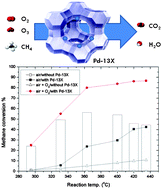Methane emission abatement by Pd-ion-exchanged zeolite 13X with ozone
Abstract
The performance of 3 wt%

* Corresponding authors
a
Department of Manufacturing Engineering and Engineering Management, City University of Hong Kong, Hong Kong
E-mail:
meoscar.hui@cityu.edu.hk
Fax: +852 2788-8423
Tel: +852 3442-4759
b School of Chemical Engineering, The University of Adelaide, Australia
c Department of Mechanical Engineering, The Hong Kong University of Science and Technology, Hong Kong
The performance of 3 wt%

 Please wait while we load your content...
Something went wrong. Try again?
Please wait while we load your content...
Something went wrong. Try again?
K. S. Hui, C. W. Kwong and C. Y. H. Chao, Energy Environ. Sci., 2010, 3, 1092 DOI: 10.1039/C002669G
To request permission to reproduce material from this article, please go to the Copyright Clearance Center request page.
If you are an author contributing to an RSC publication, you do not need to request permission provided correct acknowledgement is given.
If you are the author of this article, you do not need to request permission to reproduce figures and diagrams provided correct acknowledgement is given. If you want to reproduce the whole article in a third-party publication (excluding your thesis/dissertation for which permission is not required) please go to the Copyright Clearance Center request page.
Read more about how to correctly acknowledge RSC content.
 Fetching data from CrossRef.
Fetching data from CrossRef.
This may take some time to load.
Loading related content
